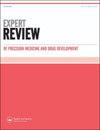Prediction and early diagnosis of immune-checkpoint inhibitor-induced inflammatory arthritis from molecular biomarkers – Where are we now?
IF 1.2
Q4 PHARMACOLOGY & PHARMACY
Expert Review of Precision Medicine and Drug Development
Pub Date : 2022-01-02
DOI:10.1080/23808993.2022.2156785
引用次数: 0
Abstract
ABSTRACT Introduction Immune-checkpoint inhibitors (ICI) works by blocking inhibitory signals of T cells. This produces an effective anti-tumor response but can also cause immune-related adverse events (irAEs). Most irAEs are transient, but ICI-induced inflammatory arthritis (ICI-IIA) might become chronic and affect the quality-of-life, or even necessitate treatment discontinuation. However, there exist no tools to identify patients that are susceptible to develop ICI-IIA. Areas covered This non-systematic review briefly presents a sparse number of studies, that have tried to identify circulating biomarkers for early prediction of ICI-IIA. Challenges, recommendations, and possibilities related to biomarker discovery in the context of ICI-IIA are then covered. Expert opinion Improved diagnosis adapted from rheumatological settings is needed for future studies to avoid a major pitfall of bad endpoints. Synovial tissue biopsies, omics technologies and particularly integration of multiple omics data is useful when searching for biomarkers of ICI-IIA and can also help unravel underlying biological mechanisms. Future biomarkers could ultimately aid clinical decision-making and facilitate early prophylaxis, pave the way for new treatment or even translational models to study autoimmune arthritis.从分子生物标志物预测和早期诊断免疫检查点抑制剂诱导的炎症性关节炎-我们现在在哪里?
摘要简介免疫检查点抑制剂(ICI)通过阻断T细胞的抑制信号发挥作用。这会产生有效的抗肿瘤反应,但也会导致免疫相关不良事件(irAE)。大多数irAE是短暂的,但ICI诱导的炎症性关节炎(ICI-IIA)可能会成为慢性的,影响生活质量,甚至需要停止治疗。然而,目前还没有工具来识别易患ICI-IIA的患者。所涵盖的领域这篇非系统综述简要介绍了少量研究,这些研究试图确定用于ICI-IIA早期预测的循环生物标志物。然后介绍了ICI-IIA背景下与生物标志物发现相关的挑战、建议和可能性。专家意见未来的研究需要根据风湿病环境改进诊断,以避免不良终点的主要陷阱。滑膜组织活检、组学技术,特别是多组学数据的整合,在寻找ICI-IIA的生物标志物时很有用,也有助于揭示潜在的生物学机制。未来的生物标志物最终可以帮助临床决策,促进早期预防,为研究自身免疫性关节炎的新治疗方法甚至转化模型铺平道路。
本文章由计算机程序翻译,如有差异,请以英文原文为准。
求助全文
约1分钟内获得全文
求助全文
来源期刊

Expert Review of Precision Medicine and Drug Development
PHARMACOLOGY & PHARMACY-
CiteScore
2.30
自引率
0.00%
发文量
9
期刊介绍:
Expert Review of Precision Medicine and Drug Development publishes primarily review articles covering the development and clinical application of medicine to be used in a personalized therapy setting; in addition, the journal also publishes original research and commentary-style articles. In an era where medicine is recognizing that a one-size-fits-all approach is not always appropriate, it has become necessary to identify patients responsive to treatments and treat patient populations using a tailored approach. Areas covered include: Development and application of drugs targeted to specific genotypes and populations, as well as advanced diagnostic technologies and significant biomarkers that aid in this. Clinical trials and case studies within personalized therapy and drug development. Screening, prediction and prevention of disease, prediction of adverse events, treatment monitoring, effects of metabolomics and microbiomics on treatment. Secondary population research, genome-wide association studies, disease–gene association studies, personal genome technologies. Ethical and cost–benefit issues, the impact to healthcare and business infrastructure, and regulatory issues.
 求助内容:
求助内容: 应助结果提醒方式:
应助结果提醒方式:


